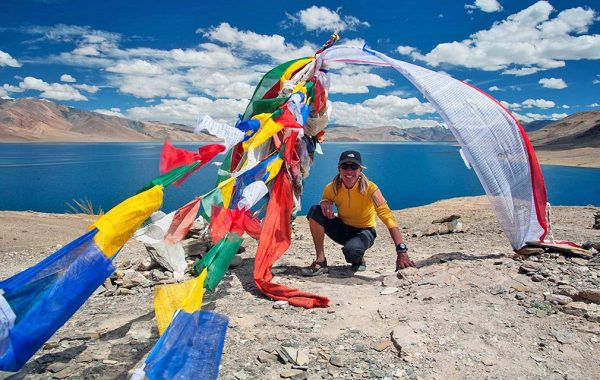
The Scene has been trying to track down Kim Bannister ’88 since last summer as the intrepid traveler has been journeying across Mongolia, cycling the Indian Himalayas, and hiking Everest. We finally had the chance to chat with Bannister to learn more about her and her company, Kamzang Journeys. She’s been leading expeditions in Asia for almost two decades and started her own business approximately 10 years ago.
Kamzang’s website seduces those hungry for an off-the-beaten-path adventure with promises of following “the old Silk Route trails in the Indian Himalayas” and “camping next to nomads in their yak-hair tents” on the banks of Lake Tsomoriri. Bannister guides expeditions from spring to winter, and each lasts between a few weeks and a month. Locations include Bhutan, Myanmar, and Tibet. On the Himalayan trips, treks typically cross several passes (many over 15,000 feet), sometimes cross rivers, and travel through traditional villages. The altitudes can be high and the trails long on these trips, but “anyone can do it,” Bannister says. “A lot of it is the mindset.” Her clients — who have ranged in age from 13 to 78 — must leave the comforts of their homes, but Bannister and her staff provide certain luxuries to make it a pleasant experience. There’s a dining tent with locally sourced food, shower and toilet tents, and music and books available in the evenings.
Since childhood, Bannister has had wanderlust. After graduating from Colgate as an English major, she spent a year and a half backpacking through Australasia. Still not ready to settle down, Bannister then hopped between Hawaii and Squaw Valley, Calif., surfing and skiing while working various jobs to save up enough for her next trip abroad.
When she landed her first — and “only real” — office job doing marketing for an adventure travel company in San Francisco, Bannister became intrigued with the idea of starting her own trekking company. A volunteer position teaching English in Nepal gave her an entrée into the Everest region, where she met two fellow trekkers who would become her business partners. Working with them, Bannister established local contacts, learned the business of running a business, and eventually went off to bring her own vision to fruition through Kamzang. Here, she fills in the details.
“Now, with the Internet, everyone goes everywhere, everyone knows about everything. To get somewhere special is difficult. So that’s what I try to do.”
“The experience is much more memorable. It’s not about sightseeing, it’s not touring; it’s about physically being outdoors, experiencing the mountains, meeting people, understanding the cultures.”
“The tent is completely open so you can look out and see the environment. You’re in a comfortable and bright place when you have your down time, and villagers can come by and visit. It’s a unique, yellow Central Asia–style dining tent.”
“A big part of the trekking experience is visiting locals. I might see somebody I know, or people might invite us in, whether they’re in a nomadic tent, or we’ll go into a house. Somebody in our group might be looking for a traditional woven blanket or rug or apron. Or we’re out looking for yogurt or fresh milk. I can speak Nepali and some Tibetan. I usually bring offerings. It’s a great way to understand how people live. And it’s pretty humbling.”
“‘Kamzang’ is a Ladakhi word. It means peace, in a broad sense.”
“We started [The Kamzang Fund] when we met Singhi wandering through a village in the Indian Himalayas. His mother was blind. He had been put in a monastery, but had run away. We found a way to get him schooling, and he became the first kid we sponsored. Then we just started helping other kids who are falling through the cracks. We sponsor approximately 30 kids for schooling. Many of them have or have had medical issues such as cleft lips, hearing issues, and speech problems. There are also a few [adult] medical cases. And, during the [2015] earthquake, we raised almost $50,000 for Nepal. We have a lot of different funds and try to help where we can.”
— Aleta Mayne






